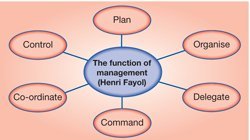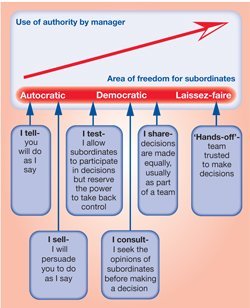
Tesco is a customer-orientated business. It aims to offer products that provide value for money for its customers and to deliver high-quality service. Tesco wants to attract new customers, but it also wants to keep its existing customers happy. Building customer loyalty is a cost-effective strategy to grow the business. This is because satisfied customers are a good advert for the business.
Tesco has more than a 30% market share of the UK grocery market, nearly double that of its nearest rival. In its 2009/2010 financial year, Tesco earned revenues of £38.6 billion in the UK and employed more than 280,000 people. To keep at the top of its game and to maintain its number one spot in the market, the company needs skilled staff at all levels and in all roles.
Roles in Tesco
Roles in Tesco range from business development, supply chain management and marketing to finance, store operations and personnel management. Each area of expertise requires leadership and management skills. Tesco aims to develop the leadership qualities of its people throughout the organisation, from administrators and customer assistants to the board of directors. It adopts a similar approach to leadership development for staff at all levels. This is in line with Tesco’s employment philosophy: ‘We believe in treating each other with respect, with everyone having an equal opportunity to get on, ensuring Tesco is a great place to work.’
This case study will show how Tesco’s leadership framework is fundamental to developing the qualities of leadership needed at every level in the business.
Management and leadership

There is a difference between management and leadership. Management is about getting things done. Managers organise human and physical resources to achieve business aims and objectives. Leadership is about influencing, motivating and inspiring people. It is about coaching and developing people, treating them with respect but challenging them. Leaders seek to create strong teams, with people committed to the organisation’s overall goals.
The process of managing starts with the target or objective to be achieved. A manager must decide on the appropriate approach for reaching that target. The manager then needs to communicate this approach clearly to his or her team and to allocate tasks to each team member. Task allocation and delegationof responsibility is part of the management function. However, other factors will also have an influence on whether the target is achieved, including the task in hand, the skills of the team and the style of leadership.

The style of leadership can vary depending on the task. Some managers allow teams to take charge of their own decision-making for many tasks. Team leaders will set the objectives but empowerteam members to decide how these objectives are achieved. This has several advantages. It helps to motivate individuals in the team and it draws on the expertise of the members of the team.
Berian is a bakery manager
Berian manages a team of 17 in a Tesco in-store bakery. One of the key challenges of Berian’s job is to ensure his team produces the right products to meet demand at key times. His usual management approach is to allow the team to take responsibility for achieving the desired result. In this way, the team not only buys into the activity, but also develops new skills. For example, when the bakery expanded its product range and Berian needed to ensure that all the products would be on the shelves by 8.00 am, rather than enforce a solution, he turned to the team for ideas. The team solved the problem by agreeing to split break times so that productivitycould be maintained. Berian’s approach produced a positive outcome and increased team motivation.
Tesco’s leadership framework sets out not just the skills and competencies but also the personal characteristics and behaviours it expects of its leaders. Tesco looks for managers who are positive, confident and genuine, with the capacity to inspire and encourage their teams. A key part of Tesco’s programme for building leaders is encouraging self review and reflection. This allows staff to assess their strengths and find ways of demonstrating the characteristics that are vital to the long-term development of the business.
Leadership styles

The business writers Tannenbaum and Schmidt categorised different leadership styles. They suggested that leadership styles could be explained on a scale ranging from ‘autocratic’ through ‘democratic’ to ‘laissez-faire’.
The autocratic or authoritarian style is characterised by an ‘I tell’ philosophy. Autocratic leaders tell their staff what to do. This can give a business clear direction but it may also lead managers to undervalue or ignore input from their teams. However, an autocratic approach is appropriate in some situations. It is valuable when the business faces a crisis or when an urgent problem arises that requires an immediate response.
Stephen is a Tesco store manager
Stephen is the manager of a medium-sized Tesco store. He has been with the company for over 10 years and his first job was filling shelves in the dairy section. He is currently working towards the Tesco foundation degree. Stephen directly manages a team of around 20 departmental managers, who between them are responsible for almost 300 people. Stephen’s leadership style is usually to allow his managers to make most operational decisions. However, if, for example, an accident occurs in the store, Stephen may take control to ensure a prompt and co-ordinated response.
There are some leadership approaches that sit between autocratic and democratic. These styles allow team participation up to a point. However, the manager reserves the right to make the final decision.
- Managers adopting an ‘I sell’ philosophy will try to persuade their teams to accept their viewpoint.
- Managers adopting an ‘I consult’ approach will seek the opinions of subordinates before taking a decision. This is moving closer to a democratic style of management.

The best managers adopt leadership styles appropriate to the situation. Stephen’s preferred leadership style is to take a democratic approach. He consults widely as he feels that staff respond better to this approach. For example, when planning a major stock reduction programme, he encourages his managers to put forward ideas and develop plans. This increases team motivationand encourages creativity. Some mistakes may be made, but they are used as a learning experience. However, as a store manager, Stephen deals with many different situations. Some may be business critical and it is important that he responds to these in the most appropriate way. In such situations, Stephen may need to adapt his leadership approach and exert more authority.
Martin is Tesco’s Programme Manager for Education and Skills

The democratic approach is characterised by an ‘I share’ philosophy. Decisions are made within teams, with each member having equal input. Martin is Tesco’s Programme Manager for Education and Skills in the UK. He has a range of responsibilities associated with people, processes and standards. Martin may use a democratic approach when setting training budgets. Managers can suggest ideas to make cost savings and they can jointly discuss their proposals with Martin. By empowering his managers, he gets them to take ownership of the final agreed budget.
Laissez-faire is at the other end of the spectrum from autocratic. A laissez-faire manager takes a ‘hands-off’ approach and trusts teams to take appropriate decisions or actions with broad agreed boundaries. For example, Martin might leave an experienced departmental manager to develop a budget. This could be because he trusts that the manager has a good knowledge of the needs of the department and of the business.
Leadership styles in action
Although each person will have their own preferred leadership style, the most effective leaders adopt a style appropriate for the situation. They will consider several factors in deciding which style to use:
- The task – Is it business-critical? Must a decision be made immediately? What will be the potential impact on the business?
- The team – Does it have the right skills and resources? Is it used to making decisions?
- Tradition – What has been the norm in the past?
For example, Martin uses a more authoritarian style if something needs achieving in a particular way or in a very quick timeframe. Sometimes budgets need to be reduced quickly in order to make cost savings. Martin will tell managers what needs to be done and by when, so that they can then resubmit their budgets in line with expectations.

Stephen regards inspiring, guiding and influencing his staff as an important part of his role. Sometimes he may need to inform his teams about a new in-store innovation or corporate initiative. Even though this is a ‘tell’ situation, Stephen aims to ‘sell’ the idea. He tries to ensure that staff understand why it is necessary. If his people are able to give their opinions, it is more likely that they will readily support the initiative.
Managers have to be aware of the possible consequences of using the wrong style in a particular situation. For example, Berian would not adopt a laissez-faire approach with a new member of the bakery team. If the employee is not given proper instruction before operating the baking equipment, the bread might be overcooked. Employees might also injure themselves if they don’t use the equipment properly. In this situation, it is essential to adopt a ‘tell’ approach.
Factors influencing leadership style
People at each level of responsibility in Tesco, from administrators and customer assistants to directors, face different types of decisions. Each comes with its own responsibilities and timescales. These will influence the most appropriate leadership style for a particular piece of work or for a given project or audience.

Tesco managers have responsibilities for ‘front of house’ (customer-facing) staff as well as ‘behind the scenes’ employees, such as office staff. Before making a decision, the manager will consider the task in hand, the people involved and those who will be affected (such as customers). Various internal and external factors may also affect the choice of leadership style used.
Internal factors include the levels of skill that employees have. Large teams may have members with varying levels of skill. This may require the manager to adopt a more directive style, providing clear communication so that everyone knows what to do to achieve goals and tasks. On the other hand, team leaders may take a more consultative approach with other managers of equal standing in order to get their co-operation for a project. External factors may arise when dealing with customers. For example, Berian may need to use a persuasive style to convince a customer to accept a replacement product for an item that is temporarily out of stock.
Critical success factors (CSFs)
In order to build a sustainable and robust business, Tesco has set out critical success factors (CSFs). These are linked at all levels to its business goals. Some CSFs apply to all employees. These are:
- Customer focus – to ensure delivery of ‘every little help’
- Personal integrity – to build trust and respect
- Drive –to achieve results, even when the going gets tough
- Team working – to ensure positive relationships in and across teams
- Developing self/others – to motivate and inspire others.
Others are specific to the level of responsibility the person or role has and covers:
- Analysing and decision making
- Managing performance
- Managing change
- Gaining commitment.
By meeting the requirements of these CSFs, Tesco managers can build their leadership skills & contribute to the growth of the business.
Tesco leaders need to be inspirational, creative and innovative, ready to embrace change and with a long-term vision for achievement. Effective leaders manage by example and in doing so, develop their teams. Tesco encourages all its managers to lead by example. It requires leaders who can motivate, problem solve and build great teams. Tesco employs people in a wide range of roles and provides a career structure that allows employees to progress through the organisation. Tesco’s process of 360-degree feedback allows its employees to reflect on their own progress and improve. Even if someone starts as working in-store filling shelves – as did Stephen – they can progress through the organisation into positions of authority and responsibility.



